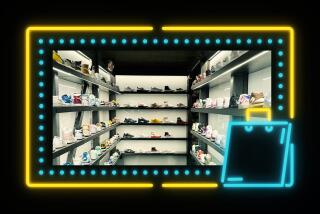Catering to your inner shopper on and off the ship
- Share via
THE specialist on the Caribbean cruise could have won the cheerleader of the year award for merchants at our destinations. This perky shopping diva told us about diamonds, watches and white T-shirts with designs that change into brilliant colors when exposed to sun. She hyped the recommended stores and a $20 coupon booklet, promising it would yield $200 in free merchandise and discounts.
She coached the audience on her shopping motto: “If you see it and like it....” she said.
“Buy it,” the audience shouted back.
Most of us listening got the impression that she was part of the cruise staff and that the shops had been selected as the best bets in the port.
In reality, she was hired by an outside company to do the shopping promotions.
As for her shopping advice, she pitched only the merchants who paid fees to get their products on the program.
A four-page map and brochure packed with promotions for recommended merchants was part of the program.
If you had read the fine print, you would have noticed that the stores had “paid a promotional fee” to be listed -- information not commonly pointed out in the talks, which repeatedly are shown in cabins on an onboard shopping channel.
Most cruise lines follow similar practices, using one of two Florida companies: PPI Group in Fort Lauderdale and Onboard Media in Miami Beach.
Even though passengers aren’t getting independent advice and tips, the shopping programs can be helpful. The recommended stores have been checked to assure they’re reputable, and the merchants give a 30-day guarantee to repair or replace any item found faulty in that time.
And, the shopping promotion companies say, they will assist passengers who have problems with a merchant within the period of the 30-day guarantee.
But the shipboard programs won’t lead you to great local handicraft boutiques, art galleries or silver merchants who haven’t paid to be promoted. Many of these local merchants offer unusual, good quality items from the region and have been in business for years.
Such local merchants are getting harder to find in many ports. Whether you cruise in the Caribbean or Alaska, more often you’ll see the same gem retailers in prime waterfront properties.
In the main town area of Cozumel, Mexico’s premier Caribbean port, Diamonds International, its sister companies and other international gem retailers dominate the waterfront boulevard.
Local merchants once reigned along the waterfront, many displaying the silver jewelry for which Mexico is renowned. Cozumel’s main boulevard still has a few local silver shops, but many merchants now are off the water a few blocks.
A few cruise lines recognize the value and attraction of local shops. Princess Cruises, for example, is working to make its shopping program more accessible to smaller shop owners who sell locally made items, says Julie Benson, Princess’ vice president of public relations.
Upscale lines, like Crystal and Seabourn, rarely use outside companies to provide shopping guides. Crystal Cruises has a shopping lecturer only on its Caribbean sailings. On its worldwide itineraries, the concierge answers shopping questions.
Seabourn Cruise Line works with a shopping person aboard only in the Caribbean. It also works with a carpet retailer in Turkey. It has a personal shopper program, allowing guests to book a local specialist to find specific items.
You don’t have to leave the ship to shop, though. Today, ships carry a broader, more appealing array of merchandise. Cruise lines, recognizing that shopping is a popular activity, have capitalized on a captive audience with time to browse and buy.
“Shops are a form of entertainment on the ship,” says Mimi Weisband, vice president of public relations for Crystal Cruises.
Lines have enhanced their onboard boutiques, often creating elegant mini-mall promenades that offer a wide variety of products, including jewelry, clothing and fragrances and cosmetics at duty-free prices.
On most cruise lines, the onboard shops are a concession run by an outside company. (Princess Cruises manages its own shops.)
Here, some advice to help you score better buys on your cruise:
Do your own research about the ports and shops. The quality of shopping information given aboard the ship varies. Occasionally, there are informative, consumer-oriented talks, but in most cases the programs are simply pitches for local merchants who have paid promotional fees.
But on an Alaskan cruise I took, a talk on buying diamonds was consumer-oriented, explaining terms and even giving insider tips on negotiating the best prices.
To find smaller, unique local vendors, you’re usually on your own.
Know prices before you go. Research before you go. Know what you’re interested in buying and the prices of those products in your hometown, because the term “duty free” doesn’t always translate to the best bargain.
Both onboard and ashore, shops promote duty-free goods, which means the retailer hasn’t paid duty, or tax, on the goods because they’re being sold to someone outside the country. The retailer gets to decide how much of that savings to pass on to you. In reality, stores in your hometown may sell similar goods with the same discount, if not more.
Brand perfumes and cosmetics -- popular ones such as Lancome and Estee Lauder -- onboard are tempting, though selections may be limited. Compare their prices onboard in your home market and shops in port before buying. In the western Caribbean, Grand Cayman Island, in particular, has a large selection of fragrances and cosmetics.
Watch for onboard sales. Almost daily, shops aboard the ship have something on sale. To get the best price, it’s wise to scope out the merchandise early in the cruise, but hold off buying to see whether items you like go on sale.
*
Mary Lu Abbott welcomes comments and suggestions but cannot respond individually to letters. She can be reached at cruisecolumn@aol.com.
More to Read
Sign up for The Wild
We’ll help you find the best places to hike, bike and run, as well as the perfect silent spots for meditation and yoga.
You may occasionally receive promotional content from the Los Angeles Times.






